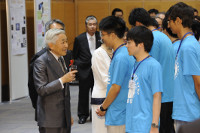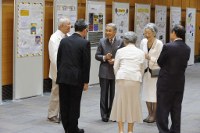 |
 |
|||||||||||||
|
|||||||||||||
|
|||||||||||||
|
A total of 182 high school and university students from 19 Asian countries and regions relished the life-changing opportunity to learn directly from eminent scientists, including seven Nobel laureates in the fields of physics and chemistry: the Asian Science Camp 2009 was held from 2 to 8 August at Tsukuba International Congress Center, Ibaraki, Japan. It was hosted by the Heisei Foundation for Basic Science, KEK and the International Center for Elementary Particle Physics (ICEPP) at the University of Tokyo. The Asian Science Camp was initiated by two Asian Nobel laureates, Yuan T. Lee (Nobel Prize in Chemistry 1986) and Masatoshi Koshiba (Nobel Prize in Physics 2002) inspired by Lindau Nobel Laureate Meetings. “The Lindau Meeting is a truly excellent opportunity for young scientists. Unfortunately, there are very few participants from Asian countries. That is why we started the Asian Science Camp,” said Lee. This camp is the third of the series, following successful events in Taipei in 2007 and in Bali in 2008. While the Lindau meeting, which aims for the transfer of knowledge between different generations of scientists, is directed at PhD students and post-docs, ASC invites science minds from younger generations, accepting students who are in sophomore year or higher. This year, ASC's youngest participant was a 13-year-old university student form India. “My desire is to share our passion for basic science research, which is worth devoting your life to, to Asian young people,” said Koshiba. “I believe that if you are doing something that you really love, you can get over any difficulties. The important thing is to find something you want to do, or you can do. This is an opportunity to find that 'something' through discussions between people from different countries.” Koshiba hopes this camp would become starting lines toward their dream. “It is disappointing to say that the research environment in many Asian countries is not good enough, except that in Japan,” said Lee, whose research activity is based in the US. “Everybody around me said that they wanted to come back to the US very soon every time I went back to Taiwan.” “I would like Taiwan and other Asian countries to have good research environments.” Koshiba also hopes to develop an atmosphere conducive to promote fundamental science, and the key facility for that would be the International Linear Collider. “My dream is to realise the ILC, hopefully somewhere in Asia,” said Koshiba. Students completed the tough seven-day tough schedule include ten lectures and excursions to various Japanese laboratories. “I chose Kamiokande because I wanted to take advantage of this opportunity to see truly unique research facility. It was excellent,” said Koththigoda Kankanamge De Silva, who went on a 19-and-half-hour day trip to the underground neutrino experiment. Others who visited National Institute of Advanced Industrial Science and Technology were impressed by robot technology and visitors to Tsukuba Space Center toured the astronaut training facility. They were also assigned to prepare the poster for presentation. Four or five students with same scientific interest formed 40 groups and each needed to prepare one poster. One group chose the Large Hadron Collider at CERN as their theme for the poster because “it is the biggest thing happening in physics.” “We are from different countries, but we all share the love for particle physics. It was a short and intense time, and preparing the poster was real fun!” said student Lee Morit from Israel. Ten groups out of 40 were given chances for an oral presentation for award selection. The quality of the posters was ‘very high’ according to the judges, and the award selection was very tough, so additional awards were created and given to eleven teams. The gold medal went to the team which made a poster entitled “ASC, ASC, and ASC…Beyond scientific classifications: Novel ways to cure.” Three teams were given the bronze medals, and two received the silvers. Their Majesties the Emperor and the Empress of Japan paid a royal visit to ASC on the day of the poster presentation. Some lucky students enjoyed the special opportunity of having a chat with the royal couple at the farewell party. “The Emperor told me about his trip to Bangladesh”, said Hasan Siddiquee, himself from Bangladesh. “He said he has been to Bangladesh twice, so I told him please come again,” he said in excitement. “I was very nervous, so I don't really remember what I said”, said Rajapaksayalage Nayana Sumanga Rajapakse from Sri Lanka, who spoke with the Empress. “I answered her question in Japanese, and she said she was impressed,” he smiled. “She was very surprised when I told her that I come from Kazakhstan,” said Assem Smagulova. “She was very friendly and frank. It was very honorable to talk with her,” she said. The royal couple also visited KEK the same day. “It was surprising to recognise that there are so many things human beings still aren't able to do even with today's advanced technologies,” said Yurika Inoue, one of the silver medalist, meaning that there are many things that young scientists like her can do in this world. The next Asian Science Camp will be held in Mumbai, India, in 2010. -- Rika Takahashi |
|||||||||||||
| © International Linear Collider |

